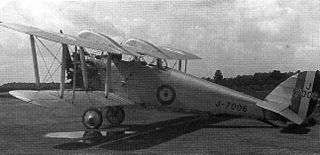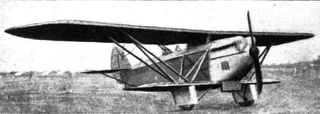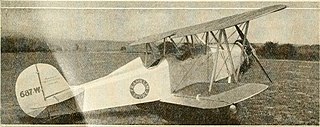
N.V. Koolhoven was an aircraft manufacturer based in Rotterdam, Netherlands. From its conception in 1926 to its destruction in the Blitzkrieg in May 1940, the company remained the second major Dutch aircraft manufacturer. Although many of its aircraft were as unsuccessful economically as they were brilliant from a design standpoint, the company managed to score several 'hits', amongst them the FK-58 single-seat monoplane fighter, the FK-50 twin-engine passenger transport, and the FK-41, built in England under licence by Desoutter.

The Koolhoven F.K.42 was a parasol-wing, two-seat training monoplane manufactured by Koolhoven in the Netherlands. Only one was built.

The Blackburn R.2 Airedale was a single-engine three-seat monoplane deck-landing aircraft for land and sea reconnaissance, built in the UK in 1924. Only two were built.

The de Havilland DH.42 Dormouse and its two variants the de Havilland DH.42A Dingo I and II were two-seat single-engined biplanes designed for fighter-reconnaissance and army cooperation roles. They did not achieve production.

The Fairey G.4/31 was a British single-engined, two-seat biplane contender for an Air Ministry specification for a multi-role or general purpose aircraft. Unsuccessful, only one was built.

The Koolhoven F.K.47 was a 1930s one-off two seat biplane designed and built in the Netherlands for an individual customer as a sport and touring aircraft.
The NVI F.K.29 was a small Dutch biplane transport, carrying two passengers who boarded after the nose, with its single engine and fuselage, had been swung open. It was intended to link small local fields to main airports.

The NVI F.K.32 was a tandem two-seat biplane training aircraft designed and built in the Netherlands in the mid-1920s. It did not go into service.

The NVI F.K.34 was a three-seat reconnaissance floatplane built in the Netherlands in 1925 as a private venture in the hope of a Dutch Naval Aviation Service order; two accidents during testing meant that it did not go into production.
The Potez 27 was a French reconnaissance biplane first flown in 1924. 175 were operated by the Polish Air Force, most built in Poland by PWS under licence. Others went to Romania, where they were also used as light bombers.

The Caudron C.33 "Landaulet Monsieur-Madame" was a French twin engined biplane with four seats, two in open cockpits and two in an enclosed cabin.

The Caudron C.25 was a large, three-engined, biplane airliner, designed and built in France soon after the end of World War I. Its enclosed cabin could accommodate up to eighteen passengers.

The Descamps 17 A.2 was a two-seat reconnaissance fighter built under a French government programme of 1923. Two versions, with different engines, were tested and six examples were built under licence by Caudron as the Caudron C.17 A.2.

The Caproni Ca.95 was a large, three engine, long range, heavy bomber prototype built in Italy in 1929. It could carry a 1,600 kg (3,500 lb) bomb load and had three defensive gun positions. Only one was built.
The Caproni Ca.61 was an Italian heavy day bomber aircraft of 1922. It was the final development of the Caproni three engine, twin boom biplane types developed during World War I, but it was not put into production.

The VIH Holland H.1 was a Dutch two seat, low-powered biplane. Only one was built.
The Caproni Ca.66 was an Italian night bomber designed to reequip the post-World War I Italian Air Force. Only two examples of the four-engined biplane were built.
The Simplex Red Arrow was a US single-engined monoplane produced in the late 1920s and early 1930s and intended as club machine or mail transport. Most used radial engines in the 90–110 hp (67–82 kW) range. They carried one or two passengers whose seats could be open or enclosed. One variant, the Red Arrow Dual Plane, was easily converted from monoplane to biplane and was available with two versions of the much more powerful Wright Whirlwind engines. In all about 20 were built.

The Franklin Sport is a two seat sport and training biplane built in the U.S. in 1930. Several different engines, in the power range 55–90 hp (41–67 kW), were fitted. Two remained airworthy in 2011.
The Vought V-100 Corsair Junior was an attempt to produce a cheaper, multi-purpose, export version of the Vought O2U/O3U observation aircraft it had produced for the United States Navy. It did not sell, and only the prototype was built.















